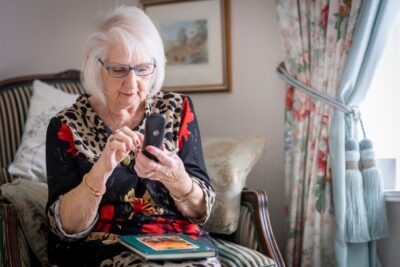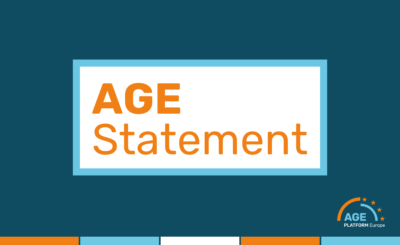 With the ageing of the population in Europe, the number of older people will increase rapidly in the coming decades, including the number of very old persons – 80 years and older – who are most likely to be in need of care. The European Union is currently seeking to boost the growth potential offered by the use of the Information and Communication Technologies (ICT) in order to improve care methods and patients’ access to health care while reducing the costs and therefore the impact of population ageing on health budgets.
With the ageing of the population in Europe, the number of older people will increase rapidly in the coming decades, including the number of very old persons – 80 years and older – who are most likely to be in need of care. The European Union is currently seeking to boost the growth potential offered by the use of the Information and Communication Technologies (ICT) in order to improve care methods and patients’ access to health care while reducing the costs and therefore the impact of population ageing on health budgets.
Potential and challenges of mobile health technology
AGE Platform Europe welcomes the developments in mHealth which could help reduce costs for social protection systems and patients alike by empowering older people to partly manage their own health and wellbeing, while being more proactive in terms of health promotion and disease prevention. Also, the innovations of eHealth bring patients and doctors closer, making care available even in the most remote areas. The combination of traditional health and ICT tools make it possible to highly increase the positive outcomes of better prevention, treatment and control of diseases.
However, for mHealth to reach its full potential there are key issues which must be tackled such as the need to further protect older consumers’ rights in that area and make sure everyone can take advantage of these technologies through appropriate training and assistance, in order to fight against e-exclusion.
In addition to the lack of accessibility of many mTools – and their price which can deter many older people from using them – issues around privacy and security, safety and transparency require strong action to overcome older people’s reluctance and concerns about mHealth applications.
Furthermore, the development of mHealth should not increase older persons’ isolation and social exclusion by substituting social contacts. Indeed, for a number of old persons in need of care the visits of medical staff to their home on a regular basis are the main external social links that remain in their daily lives. Moreover boosting employment in the ICT sector would not have the expected growth potential in terms of employment if it entails employment reduction in other sectors.
Following the publication by the European Union of its new EU Digital Strategy, AGE issued a joint statement with the European Disability Forum (EDF) in order to raise policy makers’ awareness of the barriers that deter universal digital accessibility and inclusion.
Presented on 13th May, during a joint plenary of the eHealth Week, an overview of the outcome of an EU public consultation on mHealth revealed the need to identify two types of mHealth applications: those related to essential health care or monitoring and the ones more related to wellbeing. For the first categories, regulations are necessary to ensure health safety and build consumers’ trust. To the question of regulation being a possible barrier to innovation, AGE Secretary-General Anne-Sophie, who took part as a speaker in the plenary, replied that, on the contrary, regulation provides a framework in which innovation can further develop while guaranteeing patients’ safety.
As an example, Mr Javier Ferrero Alvarez Rementeria, CIO for the Andalusian Agency for Healthcare Quality, a public foundation of the Health Department of Andalusia, Spain which promotes and develops quality policies, presented the Andalusian labelling system for mhealth applications (read more in the interview below this briefing).
Click here to access the agenda of the eHealth Week.
Emerging EU Silver Economy
The use of new technology in health and support to older people is part of the broader debate around the so-called ‘Silver Economy’ that is currently being developed in Europe, and which refers to the economic activities and market opportunities arising from population ageing. The European Commission has recently launched its Silver Economy Strategy that will seek to coordinate EU actions in that area.
As highlighted in the report Innovation for Active and healthy Ageing just released by the European Commission, the Silver Economy offers many new opportunities to create jobs and growth, improve the sustainability of healthcare and social protection systems and empower older people to live longer in good health. But for the silver economy to reach its full potential and avoid causing further discrimination and exclusion, it must also aim at fulfilling the needs and promote the fundamental rights of our ageing population. Read more in our press release
———————-
Note:
- eHealth is a generic term referring to the use of Information and Communication Technologies (ICT) in health; it covers all ICT-enabled health services and devices that are used by health professionals, carers, funders and patients.
- mHealth (mobile health) covers all initiatives that seek to enhance the health and wellbeing of individual patients through the use of mobile communication devices, such as mobile phones, tablets, patient monitoring devices and other wireless devices, and are targeted at individual citizens and patients.
Useful links:
- eHealth Week website (including presentations) + short event report
- EC Report Innovation for Active and healthy Ageing
- AGE short report of the Summit
- AGE press release following the EU Summit
- EC Silver Economy webpage
- AGE Press release on Silver Economy
- AGE and EDF joint recommendations for an inclusive Digital Single Market
———————-
INTERVIEW:
 Peteris ZILGALVIS
Peteris ZILGALVIS
Head of Unit, DG CNECT, European Commission
1/ According to the latest Eurostat data, healthy life expectancy in Europe has been reduced since 2010. How can eHealth solutions help increase the healthy life expectancy, which is seriously at stake and counts as one of the EU objectives?
The Eurostat data shows the expectancy of healthy life years in the EU demonstrating a small decrease although overall life expectancy has increased since 2002 after staying on the same level in 2011 and 2012. As the term “healthy life years” can also be interpreted as living without disability these data demonstrate in general that diseases have been diagnosed, treated and monitored quite well. Of course, ICT tools play an important role in this process by providing better research possibilities such as development of virtual physiological human or use of health records for analysis and creation of efficient decision support systems. However, for increasing healthy life years, eHealth solutions that are available for diagnosis and treatment are only one side of the coin. The other side is the role of citizens themselves in increasing their healthy life years. Take a walk, eat healthy foods, talk to your friends, solve Sudoku – these are simple things to do which don’t require ICT support. However, even in these areas, ICT can help and support: speak to your friends and family using modern communication tools, solve Sudoku on your smart-phone, which can be interactive and fun, count your steps and monitor your food intake with an app, use your telephone’s calendar to add a reminder to take your medication or vitamins. There are many possibilities that already exist, but which we are not aware of or we just don’t acknowledge the need for. It is worth noting that ICT can offer plenty of opportunities to improve citizens’ health literacy. In our Horizon 2020 Work Programmes, we have allocated a significant amount of financing for developing tools that support citizen engagement in managing their health and disease and we will continue to do so.
2/ Moreover, how can the EU ensure that such solutions do not leave anyone behind on the basis of their age, disability, resources or other grounds, in order to comply with its obligations under the Charter of Fundamental Rights and the UN Convention on the Rights of Persons with Disabilities?
Access to the Internet and ICT training for everyone, or in other words, “Include everybody” are cornerstones of our work. Referring again to Eurostat, during the last decade, ICT have become widely available to the general public, both in terms of accessibility as well as cost. In 2013, 79 % of households in the EU-28 had Internet access. Of course, access alone is not enough, digital skills are also needed for using the tools and health literacy is needed to find trustworthy information, understand the messages and to use the tools for health monitoring. Additionally, specific needs of people with disabilities need to be taken into account when developing eHealth services. I am glad to say that ICT has already helped several healthcare services becoming accessible for different groups of citizens who otherwise might have been difficult to reach. This includes people with disabilities or those who may not be easy to reach using traditional communication channels. For example, people with rather sensitive health issues in areas such as sexual health or mental health have benefitted from services provided by health professionals over the Internet.
 Javier Ferrero
Javier Ferrero
CIO for the Andalusian Agency for Healthcare Quality
1/ During the eHealth Week you presented the Andalusian labelling system for mhealth applications. Could you briefly explain in what way this system can improve the safety and quality of health apps?
Appsaludable, as part of the Andalusian Strategy for Quality and Safety in Mobile Health Applications, is a distinctive that ensures the compliance with quality and safety recommendations. It is free for app developers and open to any public and private mobile health app. The main goals of this initiative are to help citizens choose secure apps, trying to raise awareness about the importance of following quality and safety recommendations, in order to minimize risks and maximize benefits in the use of health apps.
Our quality recommendations and requirements are publicly accessible through our website, www.calidadappsalud.com, in an effort to help app developers so new apps may comply with these principles.
2/ Can you tell us how your initiative is helping older patients access the benefits of mhealth aps?
In general, due to the huge number of apps in the markets, it is really difficult to distinguish between those which are secure and those which are not. The availability of a secure apps catalog, with the support of a public administration, means a guarantee for those user groups with less technical knowledge and with less ability to discriminate, such as the older people collective. For this purpose, the regional health ministry of Andalusia is working on a mhealth corporate repository where citizens will be able to access to mhealth personalized services in a safe way.
One of the most benefited collectives will be older people, with some services like medication management, integrated with corporate prescription systems, apps for accessing more easily and with more efficiency to emergency services, or mobile services to help them follow recommendations for diagnostic tests, surgery procedures, etc.






